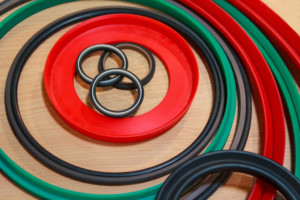
Rubber is a common material in most industrial items. Indeed, many manufacturing companies can’t function without rubber. For example, any mechanical item that runs on oil likely has a rubber oil seal. The automotive industry cannot make cars tires without rubber, and doctors in hospitals cannot do without rubber gloves. Rubber is also an essential component in electronics due to its insulative properties.
The world cannot do without rubber, but it is a material people often take for granted. In fact, you probably have never wondered about rubber. Explore some facts about rubber that you likely did not know.
1. Where Rubber Comes From
Two types of rubber exist: natural rubber and synthetic rubber. Both types come from different places.
Natural Rubber
Natural rubber is the product of sap from a rubber tree, which you probably know by the name latex. People harvesting latex make a diagonal cut across the bark of a rubber tree and collect the latex in buckets. Latex is a while and milky liquid. Asian countries are the world’s largest producers of latex rubber, accounting for 90% of the rubber produced globally.
Synthetic Rubber
Unlike natural rubber, which comes from a tree, synthetic rubber is the product of polymers manufactured from petroleum products. Synthetic rubber has better thermal and oil resistance. Because of these features, manufacturers usually use synthetic rubber and not natural rubber to produce vehicle tires.
2. How Rubber Is Made
The two types of rubber have different processes due to their varying natures.
Natural Rubber
Unprocessed rubber has little utility. Thus, it must go through several processes to make it useful. After tapping latex from rubber trees, manufacturers roll the latex through a process known as mastication to soften it.
Afterward, manufacturers mix reactive materials into the product to enhance its functionality. Manufacturers then mold the rubber into the desired shapes based on the product they want to create. The rubber then undergoes a process known as vulcanization, where it heats at high temperatures to cure.
Synthetic Rubber
When making synthetic rubber, manufacturers first create a hydrocarbon mixture, which they refine to produce naphtha. They then combine naphtha with natural gas to produce monomers, which bind molecules, creating polymers.
From there, the process is similar to that of making natural rubber. Manufacturers add chemicals to the polymers to form rubber, shape the rubber, then vulcanize it to make it more durable.
3. What the Properties of Rubber Are
The two types of rubber have differing properties.
Natural Rubber
Natural rubber is highly elastic and highly resistant to water and acids. Additionally, it does not cut, tear, or chip easily. The natural rubber also has high tensile strength and adheres well to steel. However, it swells with exposure to oils and has a low thermal resistance.
Synthetic Rubber
Synthetic rubber has excellent thermal resistance and maintains its flexibility at low temperatures. The rubber also has better abrasion resistance than natural rubber and grease and oil resistance. Synthetic rubber also has a long lifespan.
4. What Rubber Allergies Are
Some people are allergic to a protein in latex from rubber trees. Therefore, manufacturers deproteinize latex during rubber production to ensure no one gets injured from using natural rubber products. Synthetic rubber does not contain allergy-causing proteins, making it a suitable option for people allergic to latex.
Now that you know more about what a wondrous material rubber is, we hope you have more appreciation for it. At Accurate Products, we do not only know about rubber but also how to produce several rubber products for many industries, including the agricultural, automotive, HVAC, and gaming industries. Contact us today for all your industrial equipment rubber parts.